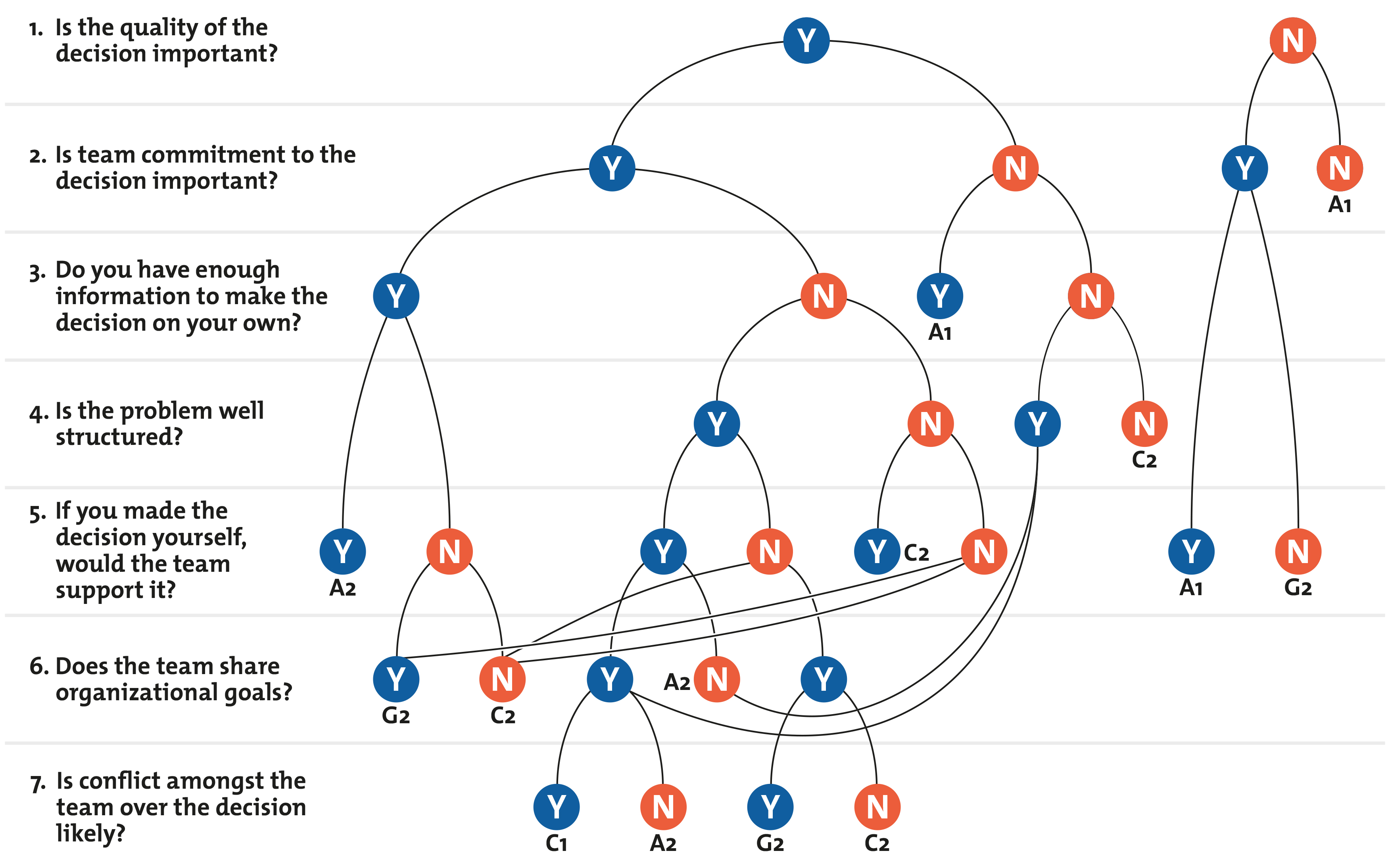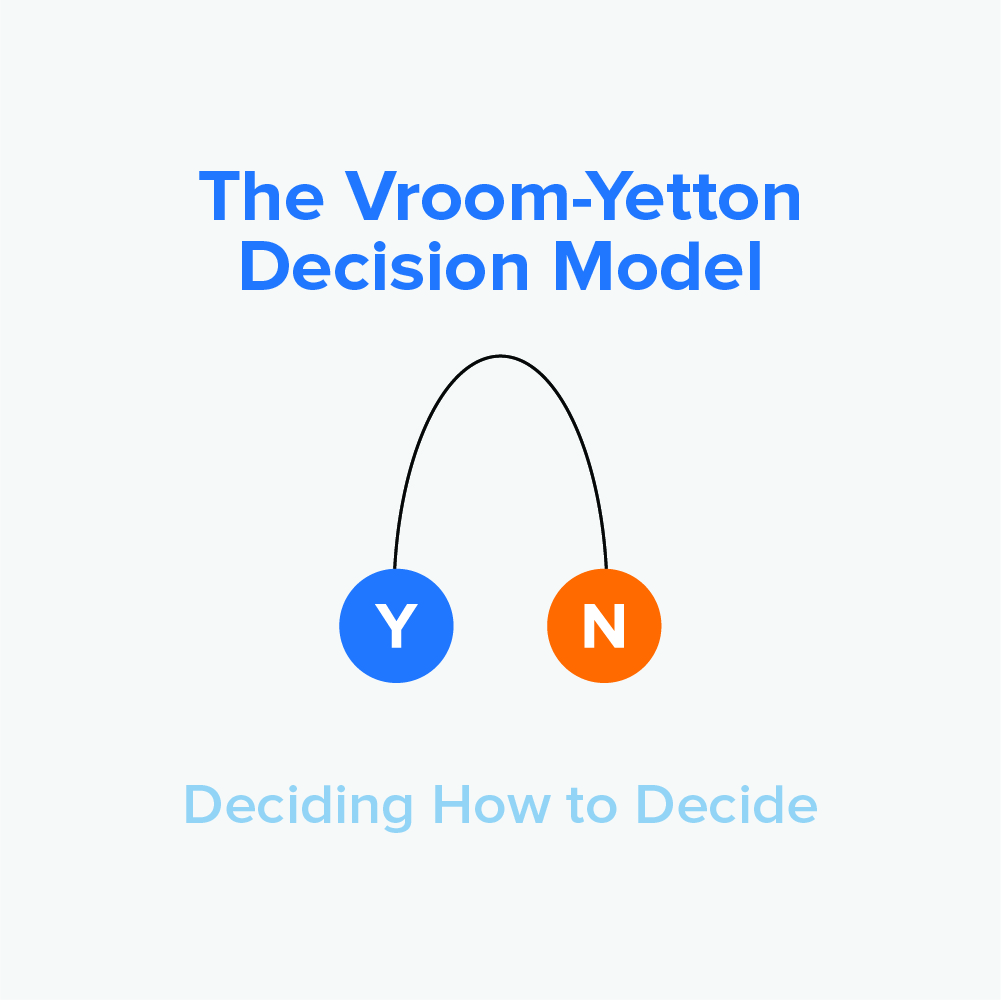The Vroom-Yetton Decision Model
Deciding How to Decide

© GettyImages
ExtremePhotographer
Steer your decision-making process in the right direction.
There are lots of different ways of making a decision, and choosing your approach can be just as difficult as making the decision itself!
Sometimes you have to take charge, and decide what to do on your own, but you don't want to appear autocratic to your team (particularly in situations where you need their input). At other times it's better to make a decision based on the group consensus, but this can use up precious time and resources. So how do you decide which approach is best?
Every manager needs to be able to make good decisions. A systematic approach to decision making, such as the Vroom-Yetton Decision Model, allows you to bring consistency and order to a process that might otherwise feel idiosyncratic and instinctive. It can also help you to determine the most effective means of reaching a decision.
Understanding the Model
The Vroom-Yetton model is designed to help you to identify the best decision-making approach and leadership style to take, based on your current situation. It was originally developed by Victor Vroom and Philip Yetton in their 1973 book, "Leadership and Decision Making." [1]
No single decision-making process fits every scenario. Instead, Vroom-Yetton offers a number of different processes and directs you toward the best one for your situation. For example, if speed and decisiveness are required then it will likely point you toward an autocratic process. If collaboration is what's needed, then it will nudge you toward a more democratic process.
Researchers have found that managers are more effective, and their teams more productive and satisfied, when they follow the model. [2][3] The simplicity of Vroom-Yetton also means that anyone – from the boardroom to the factory floor – can use it.
Although a little long-winded at times, it can be particularly helpful in new or unusual situations. Practice using it, and you'll quickly get a feel for the right approach to take, whether you're making a decision about a day-to-day issue or dealing with a more complex problem.
Before you start using the model, you'll need to consider these three factors:
- Decision quality – Sometimes, making the "right" decision is critical, and you'll need to use a large number of resources (people, time, information, and so on) to ensure that the action you take has been well thought through and is of high quality.
- Team commitment – Some of your decisions will have a major impact on your team, while others will go unnoticed. When a decision will likely impact your team, it's best to use a collaborative process. This will improve the quality of the decision, and you'll likely deliver a successful result faster.
- Time constraints – When the issue at hand isn't time sensitive, you have more "space" to research your options and to include others, which will help to boost the quality of your decision. If your time is limited, however, it may not be feasible to include others or to undertake thorough research.
Specific Leadership Processes
Figure 1, below, shows the Vroom-Yetton model. The framework poses seven "yes/no" questions, which you need to answer to find the best decision-making process for your situation.
As you answer each of the questions, you work your way through a decision tree until you arrive at a code (A1, A2, C1, C2, or G2). This code identifies the best decision-making process for you and your team. (Note that, in some scenarios, you won't need to answer all of the questions.)
Figure 1: The Vroom-Yetton Decision Model

The Vroom-Yetton Decision Tree: Adapted from Leadership and Decision Making by Victor H. Vroom and Philip W. Yetton by permission of the University of Pittsburgh Press. Copyright © 1973 University of Pittsburgh Press.
The following codes represent the five decision-making processes that are described by the model:
Autocratic (A1): You use the information that you already have to make the decision, without requiring any further input from your team.
Autocratic (A2): You consult your team to obtain specific information that you need, and then you make the final decision.
Consultative (C1): You inform your team of the situation and ask for members' opinions individually, but you don't bring the group together for a discussion. You make the final decision.
Consultative (C2): You get your team together for a group discussion about the issue and to seek their suggestions, but you still make the final decision by yourself.
Collaborative (G2): You work with your team to reach a group consensus. Your role is mostly facilitative, and you help team members to reach a decision that they all agree on.
In general, a consultative or collaborative style is most appropriate when:
- You need information from others to solve a problem.
- The problem can't be easily defined.
- Team members' buy-in to the decision is important.
- You have enough time available to manage a group decision.
An autocratic style is most appropriate when:
- You have greater expertise on the subject than others.
- You are confident about acting alone.
- The team will accept your decision.
- There is little time available.
Note:
Vroom-Yetton is a useful model, but it's not necessarily appropriate for all eventualities. It misses out several important considerations, and its rigid structure means that it fails to take into account subtleties, such as the emotions and dynamics of your team, and the task’s complexity. The seven questions are imprecise, too – "importance" and "quality," for example, are vague terms – and it can be difficult to give straight "yes" or "no" answers to them.
Vroom and Arthur Jago addressed these weaknesses and amended the original model in their 1988 book, "The New Leadership." [4] The newer model is more complex and includes several additional questions, which allow users to take other constraints, such as geographic location, into account when making their decision. It also uses a mathematical formula to help people to pinpoint the optimum decision-making process for their situation. The newer version of the model is often referred to as either Vroom-Jago or Vroom-Yetton-Jago.
Key Points
The underlying assumption of the Vroom-Yetton Decision Model is that no single leadership style or decision-making process fits all situations.
To find the process best suited to your situation, you need to consider a number of factors. These include time constraints, the level of team participation required, and the quality of the final decision.
The model walks you through these factors logically, to help you to identify the most appropriate process and style. It is particularly useful for managers and leaders who are trying to balance the benefits of participative management with the need to make decisions effectively.
Infographic
You can see our infographic of the Vroom-Yetton Model here:
This site teaches you the skills you need for a happy and successful career; and this is just one of many tools and resources that you'll find here at Mind Tools. Subscribe to our free newsletter, or join the Mind Tools Club and really supercharge your career!







Thanks for your question.
The editorial team is constantly reviewing content and updating older articles - as you can imagine this is a continuous task.
As I am sure you noticed, the more refined Vroom-Yetton-Jago is mentioned in the Notes at the end of the article so that you can explore this further if you're interested in it.
Thanks again for flagging this,
Sarah
Mind Tools Coach
Thank you for sharing your results with us. What steps will you take to improve your listening skills?
Michele
Mind Tools Team